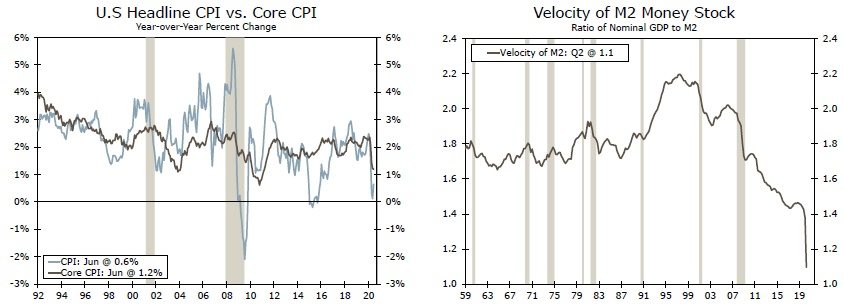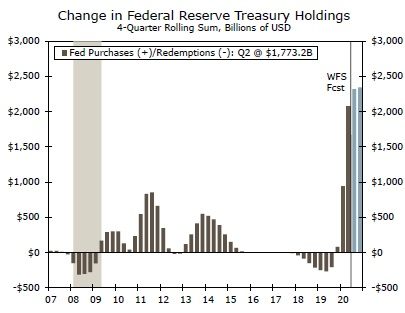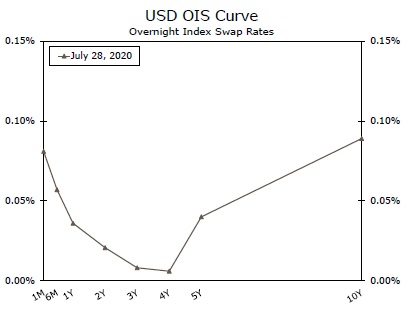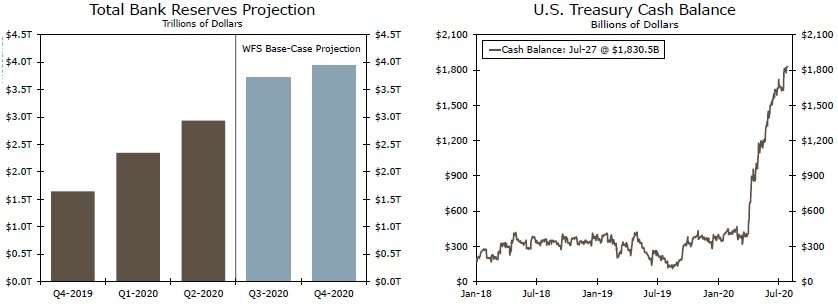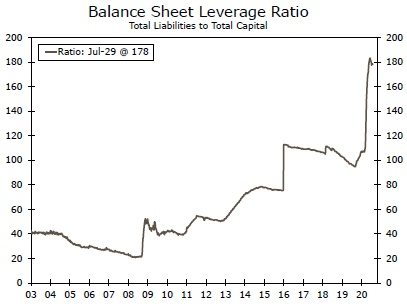Executive Summary
As a follow-up to a recently published report, we explore the implications of the phenomenal increase in the Fed's balance sheet so far this year. In our view, the expansion of the Fed's balance sheet is largely benign from an economic and financial standpoint, at least in the foreseeable future. Higher money supply growth likely will not lead to a spike in inflation anytime soon, and the Fed's purchases of high quality assets, such as U.S. Treasury securities, likely will keep bond yields low and liquidity ample in short-term funding markets. However, the Federal Reserve could become technically insolvent if it were to experience significant credit losses on some of the higher risk assets it is currently purchasing. In that event, the Fed could face a political backlash that could have potential implications for its ability to respond to future crises.
Could Balance Sheet Expansion Lead to Higher Inflation?
We estimated in a report that we published on July 14 that the size of the Fed's balance sheet, which currently stands at nearly $7.0 trillion, would grow to roughly $7.6 trillion by the end of 2020, under our base-case scenario. But in a "worst-case" scenario, in which the economy rolls over again and tensions in financial markets spike anew, the balance sheet could easily explode to $11 trillion by the end of the year. What are the implications of this significant growth in the size of the Fed's balance sheet?
As we discussed in our previous report, the current policy instruments of the Federal Reserve operate largely through the asset side of its balance sheet. That is, the Fed has been actively purchasing assets to reduce tensions in financial markets and to support the credit-creation process in the U.S. economy. The liability side of the balance sheet is essentially moving in a mechanical fashion with the asset side. In that regard, the reserves that commercial banks hold at the Fed have shot up to roughly $2.7 trillion from $1.7 trillion in early March (Figure 1).
Along with vault cash, banking system reserves constitute the monetary base, which is also known as "high-powered money." Because commercial banks need to hold only a fraction of their deposits (liabilities of a commercial bank) in the form of vault cash and reserves at the Fed (assets of a commercial bank), banks can create a multiple of loans and deposits when reserves increase. In short, rapid reserve expansion could potentially lead to a significant rise in the money supply, which could prove to be inflationary.
On a year-ago basis, the monetary base in July was up about 45% (Figure 2). But this marked acceleration in the monetary base since March pales in comparison to the experience of the financial crisis of a decade ago when "high-powered money" was surging in excess of 100%. Growth in the M2 money supply edged higher in late-2008/early-2009, but clearly not to the same extent as the "high-powered" money supply.1 As we will discuss subsequently, the so-called "velocity" of money fell sharply during the financial crisis, which kept a lid on growth in the M2 money supply.
Source: Federal Reserve Board and Wells Fargo Securities
Furthermore, headline and core consumer price inflation both fell in the immediate aftermath of the financial crisis.
But could this time be different? The M2 money supply in June was up nearly 23% on a year ago basis. Not only is currency in circulation 13% higher than it was last year at this time, but deposits at the nation's commercial banks are up more than 20% on a year-ago basis. Could this acceleration in the M2 money supply lead to higher inflation?
In the near term, the answer appears to be "no." Both overall and core CPI inflation have receded notably since the pandemic struck earlier this year (Figure 3). And if the experience of the financial crisis is any guide, inflation likely won't shoot higher as long as the economy remains depressed. But could inflation rise significantly in the years ahead? For that to happen, the velocity of money would need to reverse the downward trend that it has followed for the past few decades (Figure 4).
Source: U.S. Department of Labor, Federal Reserve Bank of St. Louis and Wells Fargo Securities
The velocity of money is the number of times that a unit of money (currency in circulation and bank deposits) is used to buy goods and services during a period of time. An increase in the velocity of money would support higher spending on goods and services, everything else equal, which could lead to higher inflation if resource constraints inhibit businesses from ramping up output quickly Although it is not entirely clear why money velocity has declined over the past two decades, the low interest rate environment over that period has likely played a role. That is, individuals are willing to hold excess cash balances if other assets are earning low rates of return. In addition, low inflationary expectations probably have contributed to the decline in the velocity of money as well. If individuals do not expect inflation to increase significantly, then they do not feel necessarily compelled to spend their cash balances before higher inflation erodes their purchasing power. As long as interest rates remain low and inflationary expectations remain depressed, a marked increase in the velocity of money does not seem likely. In other words, the recent increase in the size of the Fed's balance sheet probably will not lead to significantly higher inflation anytime soon.
As a point of reference, note that the balance sheet of the Bank of Japan (BoJ) has ballooned to nearly 120% today from 30% of Japanese GDP at the beginning of 2012. Over that period, the consumer price index in Japan has risen less than 6%, which is an annual average rate of only 0.7%. Clearly, balance sheet expansion by the BoJ has not led to a significant bout of inflation in Japan.2 This is not to say an exploding monetary base cannot lead to higher inflation, but rather that it does not necessarily need to lead to higher inflation.
Bond Yields: An Unstoppable Force Meets an Immovable Object
The Fed's robust purchases of Treasury securities have helped keep a lid on yields despite the surge in federal debt issuance. The federal budget deficit has ballooned since the onset of COVID-19, and with it has come an explosion of debt issuance by the federal government that has already surpassed the peaks seen during the Great Recession (Figure 5). This has led some financial market participants to speculate that a jump in bond yields is in the offing.
Source: U.S. Department of the Treasury and Wells Fargo Securities
But, just looking at the change in public debt outstanding ignores the role the Federal Reserve plays in the Treasury market. After accounting for the Fed's Treasury security purchases/redemptions, total net Treasury issuance this year will only be moderately higher than it was during the Great Recession. And for net issuance of securities with maturities of two years or longer, our forecast is for supply to be outright negative by more than $500 billion, after accounting for Fed purchases (Figure 6). This illustrates just how aggressive the Federal Reserve has been in the Treasury market since mid-March. At the peak, the Fed was buying $75 billion per day of Treasury securities, none of which were short-dated Treasury bills. This explosion in Treasury holdings by the central bank easily exceeds what was done by the Federal Reserve during and after the Great Recession (Figure 7).
This is not to say that debt issuance will have no impact on markets going forward. The Fed has subsequently dialed back its purchases to $80 billion per month, and the U.S. Treasury Department likely will continue to ramp up issuance of intermediate and longer-dated Treasury securities in the quarters ahead. But it is our expectation that increased debt issuance will push up longer-dated yields only at the margin over the next 12-18 months. Specifically, we forecast that the yield on the 10-year Treasury security will stand at roughly 1.5% at the end of 2021, which would still be about 50 bps below where it was at the end of 2019. For a more material breakout in Treasury yields, the economy would need to strengthen enough such that financial markets begin to price in at least some Fed rate hikes in the 2020s (Figure 8).
Source: Federal Reserve Board, Bloomberg LP and Wells Fargo Securities
Liquidity: Keeping Strains in Short-Term Funding Markets at Bay
Liquidity concerns have periodically arisen over the past year, from the spike in repo rates in September 2019 to the widespread financial market havoc that was induced by COVID-19 in midto late-March. Since then, however, money markets and other key segments of the financial plumbing have generally operated much more smoothly, aided mightily by the expansion of the Federal Reserve's balance sheet. As discussed above, bank reserves have risen nearly $1 trillion since early March, and we anticipate that they will increase by at least another $1 trillion by year's end (Figure 9). Continued Fed purchases of Treasury securities and MBS, as well as an eventual decline in the Treasury's cash balance (Figure 10), should keep new cash flowing into the financial system for the foreseeable future.3
Source: Federal Reserve Board, Bloomberg LP and Wells Fargo Securities
The sources of this extra liquidity have not just been outright asset purchases by the Fed, but also the slew of emergency lending programs by the central bank that were covered in Part I of this report. On July 28, the Federal Reserve announced that it would extend through December 31 seven of its facilities that were scheduled to expire on September 30.4 In addition, the Federal Open Market Committee FOMC) announced at it July 29 meeting that the Fed "will continue to offer large-scale overnight and term repurchase agreement operations" and that it was extending the swaps agreements that it has in place with other major central banks through March 2021. Although usage of many of these programs may remain low in the months ahead, their continued presence should help to ensure that liquidity is not a major problem. In short, the willingness of the Federal Reserve to use its balance sheet to provide liquidity to financial institutions and foreign central banks should keep strains in short term funding markets, such as those experienced in March, at bay.
Could the Fed Become Insolvent?
While the Fed's balance sheet has ballooned to roughly $7 trillion, its capital base has remained constant at about $39 billion. With this leverage ratio of roughly 175-to-1 (Figure 11), it seems plausible that a loss could wipe out the Fed's relatively meager capital buffer and leave it with a negative net worth. Although this is possible, things may not be as worrisome as this figure suggests. The Fed's balance sheet is largely comprised of assets with relatively minimal credit risk. While the Fed is adding new, riskier assets to its balance sheet through its crisis lending facilities, the Treasury has seeded these facilities with capital that can help protect the Fed from some default risk. Even if the Fed were to become technically insolvent, the consequences are much more likely to be political rather than economic.
Source: Federal Reserve Board, Bloomberg LP and Wells Fargo Securities
U.S. Treasury securities currently account for about $4.3 trillion of the $7.0 trillion worth of assets that the Federal Reserve currently holds on its balance sheet. These securities essentially have no credit risk because they are backed by the "full faith and credit" of the U.S. government. The Fed also owns $2.0 trillion worth of mortgage-backed securities (MBS). Although these securities do not explicitly have the "full faith and credit" of the U.S. government, the credit risk inherent in them is probably fairly low. In the event of another housing market meltdown, the U.S. government likely would backstop the MBS issued by Fannie Mae and Freddie Mac as it did during the financial crisis. Together, Treasury securities and MBS make up about 90% of the assets on the balance sheet and a similar share of the balance sheet's growth since early March.
That said, the Fed has created a number of programs since March that could alter the composition and credit risk of its balance sheet. For example, corporate bonds and state & municipal bonds, which the Federal Reserve is buying, have higher default risk than Treasury securities or MBS. Furthermore, the loans that the Fed is now buying from commercial banks through its Main Street Lending Program also have default risk. The amount of credit that the Federal Reserve has extended to these facilities totals about $200 billion at present, but they could grow to a maximum of $2.3 trillion, in aggregate. All of these facilities are capitalized by $215 billion from the U.S. Treasury Department, which would have any first-loss exposure. However, this equity infusion from the Treasury Department as well as the $39 billion worth of capital that the Fed holds could be completely depleted if the credit losses incurred by these facilities exceed $254 billion.5
Of course the Federal Reserve is not an ordinary commercial bank. Congress could pass legislation requiring commercial banks, which are the Fed's primary equity contributors, to re-capitalize the Fed, or the federal government could also stake a significant new equity stake in the central bank. Although the technical insolvency of the nation's central bank may not have tremendous economic consequences, falling into a negative net worth situation could have significant political implications for the Federal Reserve.
Thus far, many observers have lauded the Fed for the actions it has taken to stem the ongoing economic crisis, but these actions have also taken it into uncharted territory. Suffering significant credit losses on some these new programs could lead some in Congress to question whether the Fed's crisis mitigation efforts go beyond its mandate. New legislation or more stringent congressional oversight could weigh on the Fed's independence and its ability to respond to new problems as they arise. The Federal Reserve may face some criticism even in the absence of any solvency issues, as it did following the 2008 financial crisis. However, entering into technical insolvency, should that eventuality transpire, could lead to a political backlash that could potentially have implications for the Federal Reserve to respond to future crises.
Conclusion
The balance sheet of the Federal Reserve has expanded to nearly $7.0 trillion from about $4.2 trillion in late February. Under our base-case scenario, we project that it will grow to roughly $7.6 trillion by the end of the year, although we acknowledge that the balance sheet could climb higher if the FOMC needs to provide even more monetary accommodation to the economy. In our view, the economic and financial implications of rapid balance sheet expansion are rather benign, at least in the foreseeable future. We think there is a low probability that increased growth in the money supply will lead to a spike in inflation. The asset purchases that the Fed is undertaking should keep bond yields low while also providing ample liquidity to the financial system.
That said, we believe there could be potential political implications from balance sheet expansion. The Federal Reserve is taking on credit risk through some of the facilities it has created to support the credit-creation process in the U.S. economy. If credit losses were to become extreme, the Federal Reserve could become insolvent, at least in a technical sense. In that event, some members of Congress and/or the administration could question whether the Fed went beyond its mandate and they could take steps to reign in the Fed's independence, which could conceivably constraint the Fed's ability to respond to future crises.
Download The Full Special Reports
Recently, the stock market has experienced high levels of volatility. If you are thinking about participating in fast moving markets, please take the time to read the information below. Wells Fargo Investments, LLC will not be restricting trading on fast moving securities, but you should understand that there can be significant additional risks to trading in a fast market. We've tried to outline the issues so you can better understand the potential risks. If you're unsure about the risks of a fast market and how they may affect a particular trade you've considering, you may want to place your trade through a phone agent at 1-800-TRADERS. The agent can explain the difference between market and limit orders and answer any questions you may have about trading in volatile markets. Higher Margin Maintenance Requirements on Volatile Issues The wide swings in intra-day trading have also necessitated higher margin maintenance requirements for certain stocks, specifically Internet, e-commerce and high-tech issues. Due to their high volatility, some of these stocks will have an initial and a maintenance requirement of up to 70%. Stocks are added to this list daily based on market conditions. Please call 1-800-TRADERS to check whether a particular stock has a higher margin maintenance requirement. Please note: this higher margin requirement applies to both new purchases and current holdings. A change in the margin requirement for a current holding may result in a margin maintenance call on your account. Fast Markets A fast market is characterized by heavy trading and highly volatile prices. These markets are often the result of an imbalance of trade orders, for example: all "buys" and no "sells." Many kinds of events can trigger a fast market, for example a highly anticipated Initial Public Offering (IPO), an important company news announcement or an analyst recommendation. Remember, fast market conditions can affect your trades regardless of whether they are placed with an agent, over the internet or on a touch tone telephone system. In Fast Markets service response and account access times may vary due to market conditions, systems performance, and other factors. Potential Risks in a Fast Market "Real-time" Price Quotes May Not be Accurate Prices and trades move so quickly in a fast market that there can be significant price differences between the quotes you receive one moment and the next. Even "real-time quotes" can be far behind what is currently happening in the market. The size of a quote, meaning the number of shares available at a particular price, may change just as quickly. A real-time quote for a fast moving stock may be more indicative of what has already occurred in the market rather than the price you will receive. Your Execution Price and Orders Ahead In a fast market, orders are submitted to market makers and specialists at such a rapid pace, that a backlog builds up which can create significant delays. Market makers may execute orders manually or reduce size guarantees during periods of volatility. When you place a market order, your order is executed on a first-come first-serve basis. This means if there are orders ahead of yours, those orders will be executed first. The execution of orders ahead of yours can significantly affect your execution price. Your submitted market order cannot be changed or cancelled once the stock begins trading. Initial Public Offerings may be Volatile IPOs for some internet, e-commerce and high tech issues may be particularly volatile as they begin to trade in the secondary market. Customers should be aware that market orders for these new public companies are executed at the current market price, not the initial offering price. Market orders are executed fully and promptly, without regard to price and in a fast market this may result in an execution significantly different from the current price quoted for that security. Using a limit order can limit your risk of receiving an unexpected execution price. Large Orders in Fast Markets Large orders are often filled in smaller blocks. An order for 10,000 shares will sometimes be executed in two blocks of 5,000 shares each. In a fast market, when you place an order for 10,000 shares and the real-time market quote indicates there are 15,000 shares at 5, you would expect your order to execute at 5. In a fast market, with a backlog of orders, a real-time quote may not reflect the state of the market at the time your order is received by the market maker or specialist. Once the order is received, it is executed at the best prices available, depending on how many shares are offered at each price. Volatile markets may cause the market maker to reduce the size of guarantees. This could result in your large order being filled in unexpected smaller blocks and at significantly different prices. For example: an order for 10,000 shares could be filled as 2,500 shares at 5 and 7,500 shares at 10, even though you received a real-time quote indicating that 15,000 shares were available at 5. In this example, the market moved significantly from the time the "real-time" market quote was received and when the order was submitted. Online Trading and Duplicate Orders Because fast markets can cause significant delays in the execution of a trade, you may be tempted to cancel and resubmit your order. Please consider these delays before canceling or changing your market order, and then resubmitting it. There is a chance that your order may have already been executed, but due to delays at the exchange, not yet reported. When you cancel or change and then resubmit a market order in a fast market, you run the risk of having duplicate orders executed. Limit Orders Can Limit Risk A limit order establishes a "buy price" at the maximum you're willing to pay, or a "sell price" at the lowest you are willing to receive. Placing limit orders instead of market orders can reduce your risk of receiving an unexpected execution price. A limit order does not guarantee your order will be executed -" however, it does guarantee you will not pay a higher price than you expected. Telephone and Online Access During Volatile Markets During times of high market volatility, customers may experience delays with the Wells Fargo Online Brokerage web site or longer wait times when calling 1-800-TRADERS. It is possible that losses may be suffered due to difficulty in accessing accounts due to high internet traffic or extended wait times to speak to a telephone agent. Freeriding is Prohibited Freeriding is when you buy a security low and sell it high, during the same trading day, but use the proceeds of its sale to pay for the original purchase of the security. There is no prohibition against day trading, however you must avoid freeriding. To avoid freeriding, the funds for the original purchase of the security must come from a source other than the sale of the security. Freeriding violates Regulation T of the Federal Reserve Board concerning the extension of credit by the broker-dealer (Wells Fargo Investments, LLC) to its customers. The penalty requires that the customer's account be frozen for 90 days. Stop and Stop Limit Orders A stop is an order that becomes a market order once the security has traded through the stop price chosen. You are guaranteed to get an execution. For example, you place an order to buy at a stop of $50 which is above the current price of $45. If the price of the stock moves to or above the $50 stop price, the order becomes a market order and will execute at the current market price. Your trade will be executed above, below or at the $50 stop price. In a fast market, the execution price could be drastically different than the stop price. A "sell stop" is very similar. You own a stock with a current market price of $70 a share. You place a sell stop at $67. If the stock drops to $67 or less, the trade becomes a market order and your trade will be executed above, below or at the $67 stop price. In a fast market, the execution price could be drastically different than the stop price. A stop limit has two major differences from a stop order. With a stop limit, you are not guaranteed to get an execution. If you do get an execution on your trade, you are guaranteed to get your limit price or better. For example, you place an order to sell stock you own at a stop limit of $67. If the stock drops to $67 or less, the trade becomes a limit order and your trade will only be executed at $67 or better. Glossary All or None (AON) A stipulation of a buy or sell order which instructs the broker to either fill the whole order or don't fill it at all; but in the latter case, don't cancel it, as the broker would if the order were filled or killed. Day Order A buy or sell order that automatically expires if it is not executed during that trading session. Fill or Kill An order placed that must immediately be filled in its entirety or, if this is not possible, totally canceled. Good Til Canceled (GTC) An order to buy or sell which remains in effect until it is either executed or canceled (WellsTrade® accounts have set a limit of 60 days, after which we will automatically cancel the order). Immediate or Cancel An order condition that requires all or part of an order to be executed immediately. The part of the order that cannot be executed immediately is canceled. Limit Order An order to buy or sell a stated quantity of a security at a specified price or at a better price (higher for sales or lower for purchases). Maintenance Call A call from a broker demanding the deposit of cash or marginable securities to satisfy Regulation T requirements and/or the House Maintenance Requirement. This may happen when the customer's margin account balance falls below the minimum requirements due to market fluctuations or other activity. Margin Requirement Minimum amount that a client must deposit in the form of cash or eligible securities in a margin account as spelled out in Regulation T of the Federal Reserve Board. Reg. T requires a minimum of $2,000 or 50% of the purchase price of eligible securities bought on margin or 50% of the proceeds of short sales. Market Makers NASD member firms that buy and sell NASDAQ securities, at prices they display in NASDAQ, for their own account. There are currently over 500 firms that act as NASDAQ Market Makers. One of the major differences between the NASDAQ Stock Market and other major markets in the U.S. is NASDAQ's structure of competing Market Makers. Each Market Maker competes for customer order flow by displaying buy and sell quotations for a guaranteed number of shares. Once an order is received, the Market Maker will immediately purchase for or sell from its own inventory, or seek the other side of the trade until it is executed, often in a matter of seconds. Market Order An order to buy or sell a stated amount of a security at the best price available at the time the order is received in the trading marketplace. Specialists Specialist firms are those securities firms which hold seats on national securities exchanges and are charged with maintaining orderly markets in the securities in which they have exclusive franchises. They buy securities from investors who want to sell and sell when investors want to buy. Stop An order that becomes a market order once the security has traded through the designated stop price. Buy stops are entered above the current ask price. If the price moves to or above the stop price, the order becomes a market order and will be executed at the current market price. This price may be higher or lower than the stop price. Sell stops are entered below the current market price. If the price moves to or below the stop price, the order becomes a market order and will be executed at the current market price. Stop Limit An order that becomes a limit order once the security trades at the designated stop price. A stop limit order instructs a broker to buy or sell at a specific price or better, but only after a given stop price has been reached or passed. It is a combination of a stop order and a limit order. These articles are for information and education purposes only. You will need to evaluate the merits and risks associated with relying on any information provided. Although this article may provide information relating to approaches to investing or types of securities and investments you might buy or sell, Wells Fargo and its affiliates are not providing investment recommendations, advice, or endorsements. Data have been obtained from what are considered to be reliable sources; however, their accuracy, completeness, or reliability cannot be guaranteed. Wells Fargo makes no warranties and bears no liability for your use of this information. The information made available to you is not intended, and should not be construed as legal, tax, or investment advice, or a legal opinion.
Recommended Content
Editors’ Picks
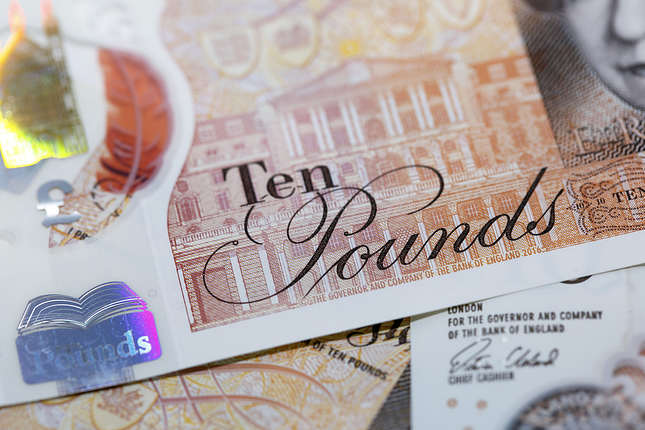
GBP/USD clings to recovery gains near 1.2600 ahead of BoE rate decision
GBP/USD holds ground near 1.2600 after declining more than 1% following the Federal Reserve’s hawkish cut on Wednesday. The Pound Sterling gains upward support as the Bank of England is anticipated to keep interest rates unchanged later in the day.

EUR/USD retakes 1.0400 amid the post-Fed recovery
EUR/USD is recovering ground to near 1.0400 in the European session on Thursday. The pair corrects higher, reversing the hawkish Fed rate cut-led losses. Meanwhile, the US Dollar takes a breather ahead of US data releases.

USD/JPY extends rally toward 157.00 on BoJ Ueda comments
USD/JPY preserves its bullish momentum and climbs toward 157.00, refreshing monthly highs following the BoJ's decision to leave policy rate unchanged. In the post-meeting press conference, Governor Ueda said they will adjust the degree of easing if the price outlook is to be realized.

Gold price recovers further from one-month low, climbs to $2,620 amid risk-off mood
Gold price attracts some haven flows in the wake of the post-FOMC sell-off in the equity markets. The Fed’s hawkish outlook lifts the US bond yields to a multi-month high and might the XAU/USD. Traders now look to the US Q3 GDP print for some impetus ahead of the US PCE data on Friday.

Sticky UK services inflation to come lower in 2025
Services inflation is stuck at 5% and will stay around there for the next few months. But further progress, helped by more benign annual rises in index-linked prices in April, should see ‘core services’ inflation fall materially in the spring.

Best Forex Brokers with Low Spreads
VERIFIED Low spreads are crucial for reducing trading costs. Explore top Forex brokers offering competitive spreads and high leverage. Compare options for EUR/USD, GBP/USD, USD/JPY, and Gold.


